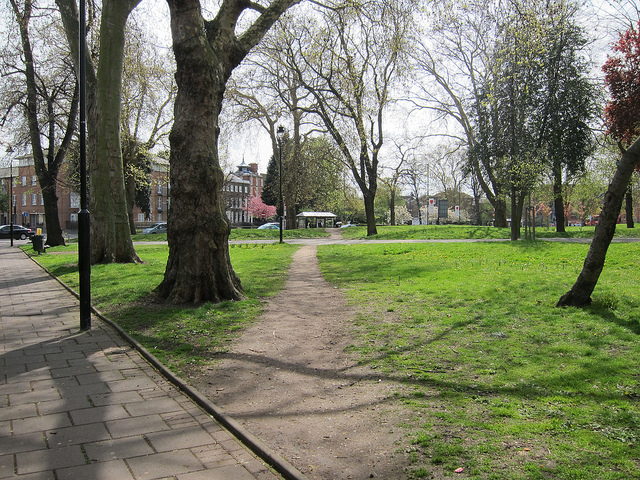Physical Address
304 North Cardinal St.
Dorchester Center, MA 02124
Physical Address
304 North Cardinal St.
Dorchester Center, MA 02124

For a reading group, I recently read two papers about the costs and (in)efficiencies around land assembly. One advocated nudging small landowners into land assembly; the other is an implicit caution against doing so. Graduated Density Zoning Although he’s mostly known for parking research and policy, Donald Shoup responded to the ugliness of eminent domain in Kelo v. City of New London, with a 2008 paper suggesting “graduated density zoning” as a milder alternative. Graduated density zoning would allow greater densities or higher height limits for larger parcels – so that holdouts would face greater risk. Samurai to Skyscrapers Junichi Yamasaki, Kentaro Nakajima, and Kensuke Teshima’s paper, From Samurai to Skyscrapers: How Transaction Costs Shape Tokyo, is a fascinating and technical account of how sweeping changes put the relative prices of different-sized lots on a roller-coaster from the 19th century to the present. First, large estates were mandated as a way for the shogun to keep nobles under his close control. Then, with the Meiji Restoration, the nobles were released to sell their land, swamping the market and depressing prices. The value of land in former estate areas stayed low into the 1950s. But with the advent of skyscrapers – which need large base areas – the old estate areas first matched and then exceeded neighboring small-lot areas in central Tokyo. A meta-lesson from this reversal is that “efficiency” is a time-bound concept. One can imagine a 1931 urban planner imposing a tight street grid and forcing lot subdivision to unlock value on the depressed side of the tracks. That didn’t happen; instead, the large lots were a land bank that allowed a skyscraper boom right near the heart of a very old city, helping propel the Japanese economy beyond middle-income status. We should take a long, uncertain view of […]

In a tweet this week, the Welcoming Neighbors Network recommended that pro-housing advocates keep supply-and-demand arguments in their back pockets and emphasize simpler housing composition arguments: This advice makes an economist’s mind race. We know, after all, that supply and demand work. But we’re not so sure about composition changes. If “affordability” is achieved by building units that people don’t want (in bad locations, too small, lacking valued attributes), then the price-per-unit can be low without actually benefiting people on their own terms. Even if existing homes are bigger than many people want, at least some of the price decline from building smaller homes is the “you get what you pay for” effect. (Incidentally, this is the opposite concern from that held by econ-skeptics concerned about gentrification: they worry that new housing will be too good or that investment will upscale neighborhoods. This inverts the trope that economists “only care about money”.) A few days later, a Maryland state senator asked me that very supply-and-demand question: “What’s the evidence that large-scale upzoning leads to affordability?” This is a tough question. First, large-scale upzonings are very scarce. Second, even if one occurs, it’s not in an experimental vacuum. Three kinds of affordability Let’s specify that an upzoning likely promotes affordability in three ways: Supply and demand You get what you pay for Only pay for what you want The first channel is obvious – it explains why Cleveland is cheaper than Boston. The second source of affordability is valuable for people at risk of homelessness, but doesn’t make most people better off. The third source – what WNN recommends advocates emphasize – is that many regulations require people to pay for more housing (or pricey attributes) that they don’t want. In a lot of cases, the last two effects will go […]

Two new estimates of the national housing shortfall offer a seeming contradiction. But we can synthesize the demand and supply models to get close to the truth: High-priced places should build much more housing than Up For Growth estimates and moderate-priced places will build much less housing than the JEC predicts.
One common explanation for high rents is something called “financialization.” Literally, this term of course makes no sense: any form of investment, good or bad, involves finances. But I think that the most common non-incoherent use of the term is something like this: rich people and corporations have decided that real estate is a good investment, and are buying it, thus driving up demand and making it more costly. But if this is true, to blame financialization for high rents and sale prices is to confuse cause and effect. If real estate prices weren’t going up, it wouldn’t make sense to buy buildings as investment. Thus, high housing costs cause financialization, not vice versa. In fact, if government did not restrict housing supply through zoning, financialization would be a force for good. Why? Because instead of buying existing buildings, people with money might be more willing to build new buildings for people to live in- which in turn might hold housing costs down. PS I am running for Borough President of Manhattan, and am gradually creating a Youtube page that addresses anti-housing arguments in more detail.

Christian Hilber and Andreas Mense argue that the price to rent ratio only increases with a demand shock where supply is sufficiently constrained
A recent paper by UCLA researchers discusses 2019-20 literature on the relationship between new construction and rents. The article discusses five papers; four of them found that new housing consistently lowers rents in nearby buildings. For example, Kate Pennington wrote a paper on the relationship between new construction and housing costs in San Francisco. What is unique about this paper is that while other papers focus on a broad sample of new construction, Pennington focuses on one subset of the market: “new construction caused by serious building fires.” Why? Because most new construction is in high-demand areas. Any study that focuses on such construction will be more likely to conclude that the new construction is related to high rents, when in fact the real cause of increased rents is increased demand for certain neighborhoods. Pennington found that rents actually decreased within 500 meters of new buildings- by 2.3 percent, compared to similar blocks without new buildings. Pennington also found 17.1 percent less displacement (which she defines as moves to poorer zipcodes) near the new buildings, and found that landlords were less likely to evict rent-controlled tenants. One paper was a partial exception to the pro-supply trend of recent scholarship: a paper by Anthony Damiano and Chris Frenier found that new buildings in Minneapolis lowered rents for most nearby buildings, but increased rents for the cheapest buildings. But the UCLA researches point out that “Damiano and Frenier do not adjust the rents in their study for inflation, which is an unusual decision, and one that makes the rent increases they report look much larger than they actually were.” Adjusted for inflation, rents near new buildings declined by 7 percent overall, and increased by only 0.2 percent for the cheapest buildings. One point that the UCLA researches do not mention: although the […]
I had always thought dollar stores were a nice thing to have in an urban neighborhood, but recently they have become controversial. Some cities have tried to limit their growth, based on the theory that “they impede opportunities for grocery stores and other businesses to take root and grow.” This is supposedly a terrible thing because real grocery stores sell fresh vegetables and dollar stores don’t. In other words, anti-dollar store groups believe that people won’t buy nutritious food without state coercion, and that government must therefore drive competing providers of food out of business. Recently, I was at the train stop for Central Islip, Long Island, a low-income, heavily Hispanic community 40 miles from Manhattan. There is a Family Dollar almost across the street from the train stop, and guess what is right next to it, in the very same strip mall? You guessed it- a grocery store! * It seems to me that dollar stores and traditional grocery stores might actually be complementary, rather than competing uses. You can get a lot of non-food items and a few quick snacks at a dollar store, and then get a more varied food selection at the grocery next door. So it seems to me that the widespread villification of dollar stores may not be completely fact-based. Having said that, I’m not ready to say that my theory is right 100 percent of the time. Perhaps in a very small, isolated town (or its urban equivalent), there might be just enough buying power to support a grocery store or a dollar store, but not both. But I suspect that this is a pretty rare scenario in urban neighborhoods. *If you want to see what I saw, go on Google Street View to 54 and 58 E. Suffolk Avenue in Central Islip.

Desire for Density is a new framework explaining how market prices form a desire path showing where the market could deliver more affordable housing than it presently is.?

Some commentators are slightly agog over an academic paper by Andres Rodrieguz-Pose and Michael Storper; Richard Florida writes that they shows that ” the effect of [housing] supply has been blown far out of proportion. ” Most of this paper isn’t really about the effect of housing supply on prices at all. Instead, the first 80 percent of the paper seems to argue that it makes no sense for low-skilled domestic workers to live in cities, because “Several decades ago mid-skilled work was clustered in big cities, while low-skilled work was most prevalent in the countryside. No longer; the mid-skilled jobs that remain are more likely to be found in rural areas than in urban ones.” (p. 20). The authors’ attack on upzoning is in the last few pages, and is based on broad, sweeping generalizations rather than actual data. First, they say that upzoning “would very likely involve replacing older and lower-quality housing stock in areas highly favoured by the market, effectively decreasing housing supply for lower income households in desirable areas.” (p. 30). They cite no source or data for this assertion- just pure conjecture. What’s wrong with their claim? First, such gentrification happens without upzoning; for example, in Chicago’s Lincoln Park, gentrification occurred through renovation of existing structures, rather than new, taller buildings- and of course places where new construction is politically difficult (such as San Francisco and Manhattan) are notorious for gentrification. Second, it assumes that new housing inevitably replaces older housing, rather than, say, vacant lots- an obvious overgeneralization.. Second, they rely on the “but we’re already building new housing!” argument. They cite a paywalled newpaper article to support this statement: “rents are now declining for the highest earners while continuing to increase for the poorest in San Francisco, Atlanta, Nashville, Chicago, Philadelphia, Denver, Pittsburgh, […]
This book is an attack on current city planning and rebuilding. This is how Jane Jacobs opened her 1961 classic “The Death and Life of Great American Cities”. It wouldn’t be an inappropriate opener for Alain Bertaud’s upcoming “Order Without Design”. While Jacobs was an observer of how cities work and a contributor to new concepts in urban economics, Bertaud goes a step further. His book brings economic logic and quantitative analysis to guide urban planning decision-making, colored by a hands-on, 55-year career as a global urban planner. His conclusion? The urban planning practice is oblivious to the economic effects of their decisions, and eventually creates unintended consequences to urban development. His goal with this book is to bring economics as an important tool to the urban planning profession, and to bring economists closer to the practical challenge of working with cities. Maybe you have not heard about Alain Bertaud before: at the time I am writing this article, he has only a few articles published online, no Wikipedia page or Twitter account, and some lectures on YouTube – and nothing close to a TED talk. The reason is that instead of working on becoming a public figure, Bertaud was actually doing work on the ground, helping cities in all continents tackle their urban development problems. His tremendous experience makes this book that delves into urban economics surprisingly exhilarating. As an example, Bertaud shows a 1970 photo from when he was tracing new streets in Yemen using a Land Rover and the help of two local assistants who look 12 years old at most, a depiction of a real-life Indiana Jones of urban planning. In this book, mainstream urban planning “buzzwords” such as Transit-Oriented Development, Inclusionary Zoning, Smart Growth and Urban Growth Boundaries are challenged with economic analysis, grounded on […]